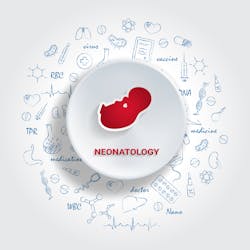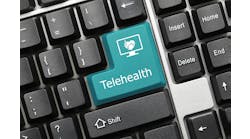According to researchers at the Rochester, Minn.-based Mayo Clinic, 10 percent of all newborn infants will require assistance at birth, while approximately 1 in 1,000 newborns will require advanced resuscitation after delivery—an intervention after a baby is born to help it breathe and to help its heart beat.
When these high-risk deliveries occur in a local referral center, such as the aforementioned Mayo Clinic, newborn outcomes can be optimized under the care of a multidisciplinary team that has frequent experience with neonatal resuscitation.
Conversely, if a similar high-risk delivery occurs in a community hospital, the local providers may face unique challenges when responding to delivery room emergencies, Mayo Clinic researchers pointed out. As such, the health system recently co-developed a Newborn Resuscitation Telemedicine Program (NRTP) in collaboration with telehealth solutions company InTouch Health.
At Mayo Clinic, the organization’s main hub in Rochester has Level III and Level IV regional NICUs (neonatal intensive care units)—Level IV being the highest level of neonatal care—but there are also 10 Mayo Clinic health system sites that range from having just Level 1 well baby nurseries up to Level II intermediate specialty care nurseries. On top of that, Mayo Clinic has eight emergency departments (EDs) that are a part of either critical access hospitals or standalone EDs where there are no labor or delivery services, explains Beth Kreofsky, operations manager for the new tele-neonatology program at Mayo Clinic.
“So when mothers present to these sites, they may not always have access to a neonatologist. Six years ago, our team identified—with the assistants of our Mayo Clinic health system pediatric teams and family medicine providers—that there was a need to have a neonatologist available for assistance at the bedside in critical care situations where newborn resuscitation was needed,” Kreofsky recalls.
This disparity based on birth location was what motivated Christopher E. Colby, M.D., chair of neonatal medicine at Mayo Clinic's Rochester campus to explore the use of telemedicine for newborn resuscitation, according to health system officials who noted that Dr. Colby’s first consultation was for an extremely preterm baby with an unknown gestational age due to limited prenatal care.
In this scenario, the local physician was unsure if the newborn was viable and if resuscitation was indicated. After examining the baby via video, Dr. Colby determined the neonate was likely 26 to 28 weeks gestation and proceeded to guide the resuscitation and stabilization. After a short time in the Mayo Clinic NICU, the baby was transferred back to the local Level II nursery. From there, the healthy infant was discharged home, health system officials explained.
The telemedicine program that has now been established enables nine board certified Rochester-based neonatologists to consult with local care teams in 10 health system sites. Prior to using telemedicine, only 43 percent of newborns in Mayo Clinic health system sites had access to a neonatologist if they required advanced resuscitation, officials pointed out, and as Kreofsky explains it, in these situations, local care teams would activate Mayo Clinic’s transport services and be asked to connect by phone to a neonatologist to assist in the service.
“Now we have added the video component onto that workflow so our neonatologists can see what the infants look like and what the physician at the local hospital is seeing, and can then provide appropriate recommendations. This is [compared with the prior approach of] not being able to see what’s going on and conducting what essentially [amounted] to a phone consult,” Kreofsky says.
This can be especially beneficial in rural settings where neonatal resuscitations are typically attended by general pediatricians or family practitioners. “While clinicians may have completed Neonatal Resuscitation Program training, knowledge and technical skills decline within four to six months, if not used regularly. Maintaining high proficiency in the face of low volumes presents inevitable challenges for rural providers. Telemedicine serves as a mechanism to address barriers in access to subspecialty care, support neonatal resuscitation in remote sites, and improve care for critically ill outborn neonates,” Kreofsky and her Mayo Clinic colleagues wrote in a study that evaluated the tele-neonatology program.
The study also examined the effectiveness of two telemedicine technologies used to provide NRTP consults: the InTouch Health Lite device compared with a wired telemedicine cart. As Kreofsky explains, if a mother needs to be moved to a different room, say for a C-section, the wired cart solution requires unplugging the device and removing it from the wall to a place where a network jack could be found. And if the physician gets disconnected during that transition, he or she would have to reconnect once the network is reestablished on that device.
But the InTouch technology, on the other hand, allows the physician to stay connected as the patient is being transitioned, meaning the transition is “more seamless and you don’t have to worry about unplugging anything or reestablishing connections in this scenario,” says Kreofsky.
Kreofsky also clarifies that when a tele-neonatology service does occur, neonatologists are able to partner with the local family medicine physician and pediatrician to assist with guidance and recommendations, but it’s the bedside physician who is still in control of all the care that’s happening on site. “So while a neonatologist cannot physically get their hands on a patient, he or she can assist with recommendations on how neonatal resuscitation program standards are followed throughout a resuscitation,” Kreofsky explains.
During the 20-month study period, 118 NRTP consultations were performed across Mayo Clinic sites, resulting in:
- 96 percent first connection attempt rate—the ability of the device to connect to the network on the first try.
- 93 percent incident resolve rate—the ability of the provider to easily resolve any issues with the device before patient care is impacted.
- Results of the NRTP device can be compared to a traditional wired cart, which saw a 73 percent connection attempt rate and a 68 percent incident resolve rate.
Kreofsky also notes that more recent satisfaction survey results found that 99 percent of the local care teams who have been surveyed agreed that they would use tele-neonatology again and would recommend it to others. Further, 100 percent of Mayo Clinic’s local care teams surveyed agreed that the consulting neonatologist provided, brief, clear, and specific information for the team, and worked collaboratively with them locally via telemedicine.
According to Jennifer L. Fang, M.D., with neonatal medicine at Mayo Clinic in Minnesota, the next step is to study the impact telemedicine has on the quality of newborn resuscitations. "While we and our colleagues in the health system believe telemedicine is improving delivery room care, we need to design a study to better answer that question," she said.


